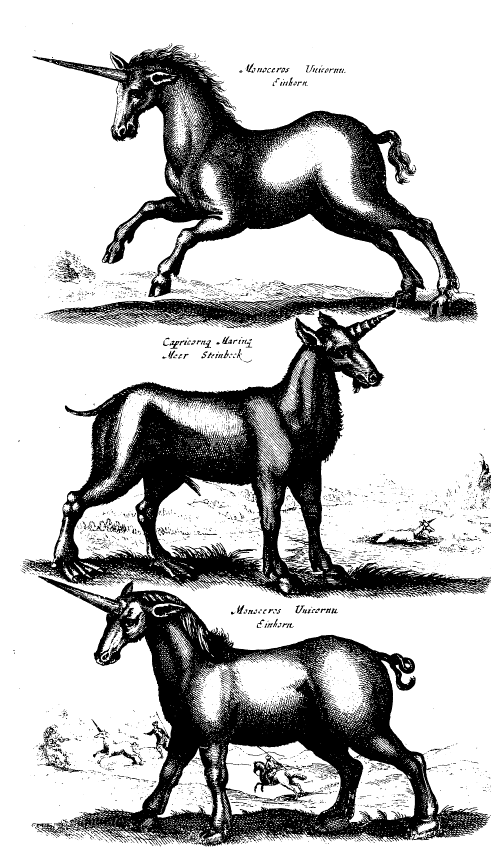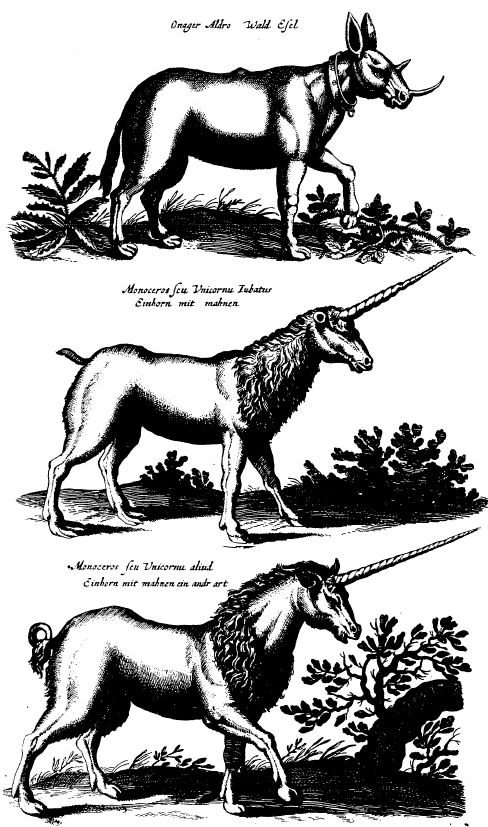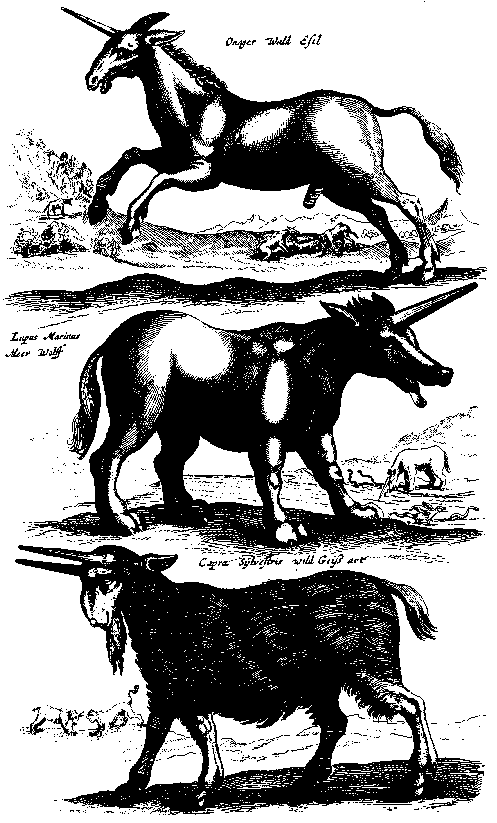
From Joannes Jonstonus (1657) Historia Naturalis, in the partial translation of "J.P." (Amsterdam, 1678), John Johnston: A Description of the Nature of Four-Footed Beasts, pp. 19-21 and Tables X-XII.
CHAPTER VI.
Of the Unicorn, and of the Horned-Asses.
THE name of Monoceros, that among the Latines sounds so much, as a one-horned beast, agrees to many creatures;1 but in a strict sense, is retained to one alone, namely that, who from having but one horn, bears the name of Unicorn. In the Brachmans dialect, called Kartazonon, whether there is, or hath been such a beast in nature: I shall elsewhere examine, after Baccius, and Bartholinus, the great son of so great a father. For present we shall treat hereof briefly, as resting on the fidelity of Relators.
As for the description of the Unicorne,2 he is said to resemble in his whole body the Horse: He is tailed like a Boor, grins and snarls like a Lyon, headed like an Hart, footed like an Elephant,3 furnisht with one onely horn, and that a black one, two cubits long, standing in the midst of his fore-head.4 Isidore makes him all one with the Rhinoceros, and saith that his horn is so sharp and strong, that what ever he strikes at, he shatters, and peirces it through. There was one seen in the service of the great Cham of Tartary, in the Kingdome of Lambris.5 They are lesse then Elephants, holding their head downwards, like a Swine, of a prickling tongue, wherewith they get what they meet with; black eyed, and very like the Rhinoceros. Lewis of Barthema of Bononia, writes thus of the Unicorns seen by him: There are Dens on the one side of the Temple at Mecca, wherein are kept two Unicorns, that are showen, as the manner is, for a rarity.6
Concerning the shape: The greater resembled a Horse-colt of thirty months old; his horn, that he bears on his fore-head, is about three ells in length;7 the other was a year old, his horn grown to four hand-breadth.
The colour of the beast, somewhat darker then that of a Sumpter, or Pack-horse, headed like a Hart, short-necked, and thin-haired thereabout, short-mained, and that hanging only on one side: Small, and slender-legged, like a Hinde; the feet a little cloven afore, Goat-hoofed, the feet hairy on the right side. He seems scarce, and of a nature affecting lovelinesse. I adde not what Garzias hath out of Hortus:8 They are said to be found in the Arabian Deserts, and to have been seen there by Merchants; as also between the Cape of Good-Hope,9 and that they call the Currentes. Some are in the Kingdom Basma, and Lambris; some in the utmost parts of Asia, in the Province Macinus, between the mountains of India, and Cathay, where the Serici inhabite. Some in the new world.10 The Horn is shewn in many places; the most famous are, S. Denys in France, Venetia, Spain, Utrecht, Helvetia, Denmark, Hampton-Court in England, Windsor,11 and the Gedansian of Empiricus. That at S. Denys is of greatest note, being rugged, not polished, blackish, and nearest those Ancients describe. Writers differ about the Unicorns horns lenth, Renodæus makes him as long as a mans hight, he takes it on trust, as we do. Baccius, and Marinus bring it to six cubits: Golnitzius his measure is six foot and an half: Bellonius makes it up full seven foot.12 Nor do they agree about the weight. Cardan saith, one hath been seen to weigh seventeen pound, and there quarters. Golnitzius rises it to five and twenty. I with Bellonius should judge the horn to weigh eighteen pound, having poysed it in my hand. Baccius thinks the Venetians are right. Marinus, that they are longer then old ones, nor so writhed as Ælians, and so thin, that they cannot be drunk out of. Coloured like a smooth Harts-horn, and pale, not black. They are reported at the siege of Bysantium, to be conveyed to the Venetian Common-wealth, with twelve breast-plates of Imperial Cavaliers.13 The Spanish one hath nothing singular, a piece whereof Phil. IV. presented to Cardinal Francis Barbarine, an eminent man, and most courteous to strang Gentery.
That at Utrecht is as long as that at Paris, and reasonable great; much wreathed at top, and then growing straiter toward the bottome. The outside is of a sand-colour, the inside is whiter. It is held in great account, and is shown for a right one, so that Colonia Agrippina, hath bid a great summe of gold for it. That of the Helvetians, was found in the year M.D.X.X. at the mouth of the River Arula, near Brugia;14 white it is within, yellowish without, without writhings, two cubits long, but as sweet as musk, especially if it be near the fire. The Danish one is kept in Fredericks-Burgs Castle, above seven Roman-foot long, if we except that part within the hollow, which Bartholine conceives to be above a foot, it is seven fingers about, writhed all along, and sharp-pointed at top; the colour mixt of white, and ash-colour, and in some of the spaces channeld, and chamfered with black, and duskish streaks. That of the Venetian Merchants, was brought out of Germany, promising by the bright, and divers colour'd shape, that it is a right one; and the rather, because there fall pieces from it, if you have it, not like teeth, and shavings, that can be crumbled; but there come thence shavings that are clammy, and yeelding, as any other cut hornes. I can say litle of the Gedanensian one. Empiricus returning from Constantinople, not long ago, magnified it highly. More about this beast Ælian tells us,15 saying, that among all beasts he hath the must absurd vile voyce; that if other beasts come to him, he is gentle, but ever fighting with those of his owne kind; the males do not onely quarrell, but they also with the females, so that they kill one another. His whole body is very strong, but his horn invincible. He seeks deserts, and goes ever alone wandring. At coupling-time the male is tamer, and feeds quietly with the female; when that time is over, and the female begins to swell, the male returns to his former fiercenesse, and betakes him to his wandring lovelinesse.16 Men say that there were some of their young ones brought to the Prasian King, and that on feast, and triumph-dayes, they were put together to fight, to shew their strength: for no man ever remembers that one growen up, hath been taken. So far Ælian. Some add, that this beast loves young Virgins so, that if one spreads but her lap, as he comes, he will lay his head there, and fall in a slumber, and so is taken.17 For their use, all know how they are commended for the soverain vertue of their horne against venome, for where poyson is, it sweats, and drops stand on it; and so, as some think, the right horne is knowne. Aloysius Mundella, commends it against the bite of a mad dog, and other mischievous beasts, as also of worms. The ancient Indian Kings, who first arrived at the knowledge of this horne, made cups of it for themselves, that drinking out of them, they might fence themselves against poyson, drunkennesse, falling sicknesse, and other malignant diseases. A Iew of Venice, made a circle on a table with that horn, and cast then a Scorpion, and a Spider within it, who had not the power to passe that circle:18 after that they being pluckt by it a hand high, whether by the shadow of it, or the vertue flowing from it, they were both kill'd, within the space of an hour. No wonder then that it is so valued, that German Merchants ask'd for one of the 90000 crowns;19 and the Pope, setting up a kind of an Apothecaries shop in the Vatican, gave 12000 pieces of gold to the Epidaurian Merchants, for a piece of an Unicorns horne; of the which Austin Ricchus the Popes then chief Physitian, used to put now a scruple, now 10 grains in wine, or cordiall water, and administred it with great successe. And thus shall serve now to have spoken of the Unicorn, we shall say more elsewhere. Concerning horn'd Asses, I find them cried up in three places, namely in India, Scythia, and Africa.20 Herodotus mentions the African. Ælian saith that they hold the water of the River Styx, and were sent in yron vessels by Alexander to Delphos, to be there dedicated to Pythia. Of the Indian ones, the same Ælian thus:21 I have been informed, that there are wild Asses, no lesse then Horses bred among the Indians, white bodied, onely purple-headed, and blew-eyed, and that they bear a horn in the forehead, a cubite and half long; the upper-part whereof is light red, the lower white, and the middle coalblack; and that, not all, but the principall Indians have hang'd them as bracelets on their arms, and set them off with gold, and have use to drink out of the same. They report, that, who so uses to drink out of this horn, shall be free from incurable diseases, nor shall be ever troubled with convulsion fits, nor ever toucht with the falling-sicknesse, nor tainted with any poyson; nay, that if he hath drunk any venome, he shall cast it up again, and recover his health.22 And when other Asses, all the world over, whether tame, or wild, and all other wholehooft beasts have, as it is said, nor ankles, nor gall in their liver: These Indian Asses onely have ankles, and these black, and that within, if you break them, neither want they a gall; and that in swiftnesse, they exceed not onely by much other Asses, but also by far both Elephants and Horses. And when they come first on the way, their pace is but slow at beginning, but then they mend it by degrees, and at last none can overtake them.23 After the females have brought forth, the sires very carefully looke to the colts, and their haunt is the most desert parts of India: when the Indians hunt them, they hold the colts feeding behind them, and fight for them: they dare meet the horsemen face to face, and make at them with their hornes. So strong are they, there is no resisting of them, they make all yeeld, or what will not. they break, or so shatter, that it become uselesse, and is quite spoyl'd. If they meet with horses they rend, and tear their sides in pieces, that their very guts fall out, so that horsemen are affraid to come near them, knowing that the approach is the utter lamentable destruction, both man and horse, they lay finely about them with their heels. What ever they bite, they make an utter riddance of it. If they be once grown up, they are not to be taken; they are kill'd with darts and arrows. Their flesh is so bitter, it is not to be eaten. Philostratus writes almost the same.24 The figure that we have here added,25 is of a wild beast bodied, and eared like an Asse, with two hornes, one shooting out of his nostrills, the other about his eyes; but because it is not whole-hoof'd, nor one-horn'd, it cannot be the Indian Asse.
NOTES
1. Aldrov. H. Quad. L. I. c. 16. [Jonston's marginal note; unmarked notes on this page are his.]
3. Pliny. [Pliny HN viii.76 (englished by Holland, Book VIII, Chap. XXI); note that there are two single-horned beasts, the "unicorn", Holland's "boeuf", with solid hooves, and the "monoceros", Holland's "Licorne or Monoceros", with feet like an elephant.]
4. Solinus.
5. M. Paul. Venet. l. 3. c. 15.
6. Vartoni l. 1. c. 18. [i.e., Lewis Vartoman, Ludovico Barthema, Lodovico de Varthema, etc., in his Itinerario. ]
7. [The unicorn's horn grew over the ages, but this, out of Vartoman, is probably the highest estimate; 135 inches or 11 and a quarter feet. Some Arab versions of the unicorn are similarly equipped; but the creators of these beasts have at least added a proviso that the horn is so long that the beast cannot lift its head.]
8. [I.e., Garcia ab Horto.]
9. Bartholi[nus] de Unicor[u Observationes Novae] c. 24. [This book, by Thomas, the second in the monoceromanic Bartholini dynasty, was published in 1645; a second edition, with additions by his son Caspar, was published in 1678. Sheppard, in his Lore of the Unicorn, calls it "the most extensive and impressive work ever devoted to the unicorn", but adds that it might have been better "if the author had devoted to it his best powers instead of regarding it as a toy of scholarship". One scarcely knows how to take that.]
10. Car. H. Arom. l. 5. c. 14. Paul. Venet. Aene. Sylv. Cadam.
11. [Sheppard, Lore of the Unicorn, lists a large number of English and other European unicorn horns, and speculates on the fate of that of Windsor:
But by far the most famous of all British alicorns was the great "Horn of Windsor" which the German traveller Hentzner saw in 1598 and valued, if his Latin text is to be trusted, at one hundred thousand pounds. We know exactly when and where this horn was discovered; it was picked up on the twenty-second of July, 1577, on an island in Frobisher's Strait, and we are told that when it reached England it was "reserved as a jewell by the Queen's Majesty's commandment, in her wardrobe of robes." We have also a dark hint as to what became of it, for Thomas Fuller, speaking of it and the Tower Horn, both of which he had seen in his youth, remarks: "It belongs not to me to inquire what became of them", and then somewhat later he says that a unicorn's horn has been presented to his Majesty "to supply the place of that in the Tower which our Civil wars have embeseled". We may infer that the Horn of Windsor was "embeseled" at the same time.]
12. Baccius, l. 2. c. ult. Renod. l. 3. Pharin. c. 21. [Marini and Bacci wrote books pro and contra the unicorn, respectively.]
13. [Sheppard argues that at least one of the two horns of St. Marks, which are still described as having come from the sack of Byzantium, is not old enough (pp. 106-107); the third horn is larger and its history clearer.]
14. Bartholin. de Unicor. c. 27.
15. H.A. l. 16. c. 20.
16. [Here, as above, this is the word in print. Perhaps a printer's error for the "loneliness" that is indicated.]
17. Albert. H.A. l. 22. [Along with a long list of others.]
18. Iordan. L. de Peste. [Paré and Marini, however, both attempted the same experiment, and a variety of similar ones, with toads, spiders, and so on, all of whom came and went at will and suffered no ill effects. To judge from the illustrations at the end of the book, the mere presence of a unicorn or unicorn-like creature will send serpents scurrying: see the picture of the "Meer wolf" below, Table XII.]
19. Baccius.
20. l. 4. H. A.
21. l. 4. c. 32.
22. Ctesias.
23. [It seems clear from the description of the animal's gait that this is the Indian rhinoceros.]
24. Vit. Apollon. l. 9.
25. [In Table XI, where it is labelled an Onager and "Wald Esel".]
UNICORNS AND THEIR ILK



This page is by James Eason.